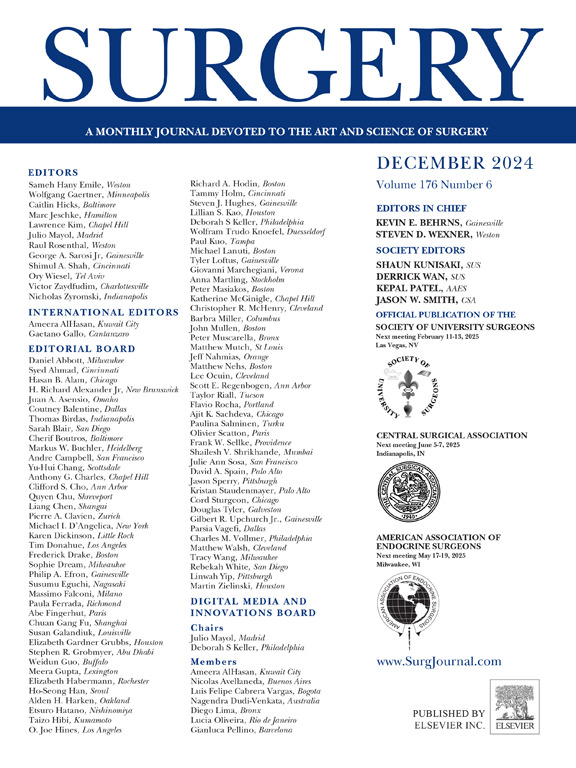Tracking patients with lower-extremity fracture in a trauma registry who develop an infection after discharge
IF 3.2
2区 医学
Q1 SURGERY
引用次数: 0
Abstract
Background
Lower-extremity fracture infections in patients with trauma represent a substantial burden; however, quality improvement initiatives are limited to the acute hospital admission, for a complication that often develops after discharge. We tracked patients with a lower-extremity fracture who developed an infection after discharge from their index trauma center admission and characterized factors associated with this complication using collaborative quality initiative data.
Methods
Trauma collaborative quality initiative data (1/2018–9/2022) were analyzed from 35 American College of Surgeons Committee on Trauma–verified Level 1 and Level 2 trauma centers and were linked to insurance claims to create a longitudinal patient record. Inpatient and postdischarge lower-extremity fracture infection rates and the location of subsequent follow-up were captured. Multivariable logistic regression assessed the factors associated with developing a postdischarge infection.
Results
There were 11,017 patients with a lower-extremity fracture and 380 (3.4%) developed an infection after discharge, and very few during the index trauma center admission. An open injury increased the probability of an infection by 3.61 percentage points, along with male sex (0.93 percentage points) and multiple medical comorbidities. Almost two-thirds of the infections were diagnosed at a location other than the index trauma center.
Conclusion
The overwhelming majority of lower-extremity fracture infections occur after discharge from the index trauma center, and most patients seek care at another location. Known risk factors for developing an infection were confirmed in this large population-based cohort. We successfully linked trauma registry patients with insurance claims to create a longitudinal patient record, which will allow for further studies in this population.

在创伤登记处追踪出院后发生感染的下肢骨折患者
背景:创伤患者下肢骨折感染是一个巨大的负担;然而,质量改进措施仅限于急性住院,因为通常在出院后出现并发症。我们追踪了从创伤中心出院后发生感染的下肢骨折患者,并使用协作质量倡议数据描述了与该并发症相关的因素。方法分析来自35家美国外科医师学会创伤认证一级和二级创伤中心的创伤协作质量倡议数据(2018年1月至2022年9月),并与保险索赔相关联,以创建纵向患者记录。观察住院和出院后下肢骨折感染率及随访地点。多变量logistic回归评估与出院后感染相关的因素。结果下肢骨折患者11017例,出院后发生感染380例(3.4%),入院时极少发生感染。开放性损伤使感染的可能性增加了3.61个百分点,男性(0.93个百分点)和多种医疗合并症也增加了感染的可能性。几乎三分之二的感染是在创伤中心以外的地方诊断出来的。结论下肢骨折感染绝大多数发生在外伤中心出院后,多数患者在其他地方就诊。已知的发生感染的危险因素在这个以人群为基础的队列中得到确认。我们成功地将创伤登记患者与保险索赔联系起来,创建了一个纵向的患者记录,这将允许在这一人群中进行进一步的研究。
本文章由计算机程序翻译,如有差异,请以英文原文为准。
求助全文
约1分钟内获得全文
求助全文
来源期刊

Surgery
医学-外科
CiteScore
5.40
自引率
5.30%
发文量
687
审稿时长
64 days
期刊介绍:
For 66 years, Surgery has published practical, authoritative information about procedures, clinical advances, and major trends shaping general surgery. Each issue features original scientific contributions and clinical reports. Peer-reviewed articles cover topics in oncology, trauma, gastrointestinal, vascular, and transplantation surgery. The journal also publishes papers from the meetings of its sponsoring societies, the Society of University Surgeons, the Central Surgical Association, and the American Association of Endocrine Surgeons.
 求助内容:
求助内容: 应助结果提醒方式:
应助结果提醒方式:


